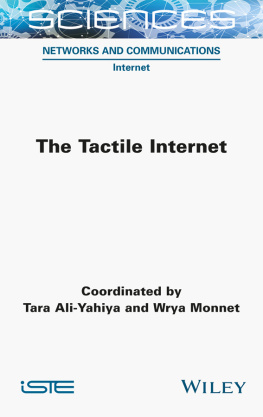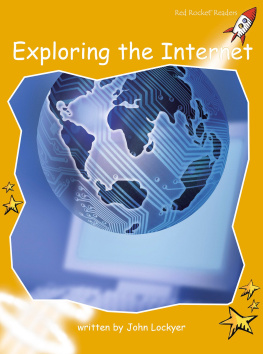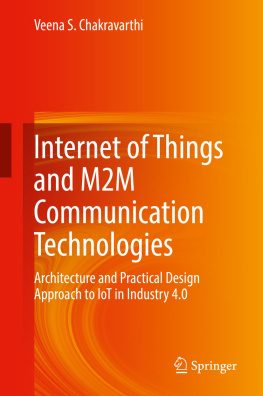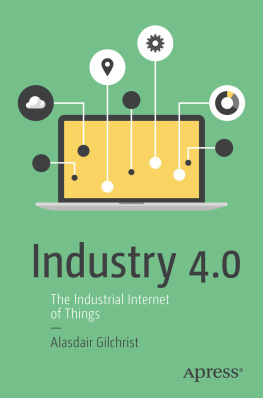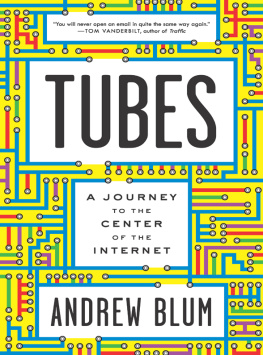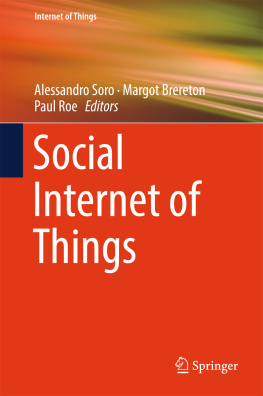SCIENCES
Networks and Communications, Field Director Guy Pujolle
Internet, Subject Head Stefano Secci
The Tactile Internet
Coordinated by
Tara Ali-Yahiya
Wrya Monnet

First published 2021 in Great Britain and the United States by ISTE Ltd and John Wiley & Sons, Inc.
Apart from any fair dealing for the purposes of research or private study, or criticism or review, as permitted under the Copyright, Designs and Patents Act 1988, this publication may only be reproduced, stored or transmitted, in any form or by any means, with the prior permission in writing of the publishers, or in the case of reprographic reproduction in accordance with the terms and licenses issued by the CLA. Enquiries concerning reproduction outside these terms should be sent to the publishers at the undermentioned address:
ISTE Ltd
27-37 St Georges Road
London SW19 4EU
UK
www.iste.co.uk
John Wiley Sons, Inc
111 River Street
Hoboken, NJ 07030
USA
www.wiley.com
ISTE Ltd 2021
The rights of Tara Ali-Yahiya and Wrya Monnet to be identified as the authors of this work have been asserted by them in accordance with the Copyright, Designs and Patents Act 1988.
Library of Congress Control Number: 2021940372
British Library Cataloguing-in-Publication Data
A CIP record for this book is available from the British Library
ISBN 978-1-78945-020-0
Foreword
Ian F. AKYILDIZ
School of Electrical and Computer Engineering, Georgia Institute of Technology, Atlanta, USA
I, Ian F. Akyildiz, have been Ken Byers Chair Professor in Telecommunications at the School of Electrical and Computer Engineering at the Georgia Institute of Technology for the past 35 years. I have vast research experience in wireless communications and many research contributions, including IoT and wireless sensor networks. My h-index is 127 and the total number of citations is 122+K according to Google Scholar as of January 2021. Dr. Tara Ali-Yahiya, Associate Professor at the University of Paris Saclay, and Dr. Wrya Monnet, Assistant Professor at the University of Kurdistan Hewlr, have been active in this research field for many years. They have introduced this book as an initiative to explain the Tactile Internet to a wide audience in a simple and clear manner.
The Tactile Internet is envisaged to change not only the landscape of network communication but also the lifestyle of society socially and economically. The huge number of use cases introduced by this concept would play a major role towards shaping our imagination for delivering not only data but also skills through the Internet from a source to a remote destination.
This book provides an introduction to the Tactile Internet and its case studies, with its impact on the democratization of haptic applications based on the IEEE 1918.1 standard through teleoperations. The case studies are based on cutting-edge technologies that enable the deployment of the Tactile Internet. 5G, and recently 6G, Software-Defined Networking, the different learning techniques in the artificial intelligence domain, edge computing for service proximity, etc. are all factors that will support the successful deployment of the Tactile Internet. This book is a solid contribution to this research area.
May 2021
Preface
Tara ALI-YAHIYA
Department of Computer Science, University of Paris-Saclay, France
Department of Computer Science and Engineering, University of Kurdistan Hewlr, Erbil, Iraq
This book attempts to provide an extensive overview on the Tactile Internet paradigm, which is considered to be the focus of interest around which all the cutting-edge technologies are centered. This is due to its wide applications and use cases that would change our lifestyle. This book is purposely written to appeal to a broad audience and to be of value to anyone who is interested in the Tactile Internet. The audience can be in any domain of computer science, communication and networking. The aim of this book is to offer comprehensive coverage of current state-of-the-art theoretical and technological aspects of the Tactile Internet. The presentation starts from basic principles and proceeds smoothly to more advanced topics. The schemes provided are developed and oriented in the context of very actual closed standards, i.e. IEEE 1918.1.
Organization of this book
This book is organized to follow a methodology of writing depending on how the Tactile Internet is tackled based on the level of difficulty that the audience can face while reading. Hence, we preferred to begin this book with a brief introduction of the tactile concept and its relationship with the Tactile Internet paradigm through cyber-physical systems in tackles the 6th Generation of wireless network and its role in boosting the Tactile Internet by adding more intelligence at different levels of the paradigm.
In . In this chapter, the perception of haptics in robots is explained: the material, shape and pose recognition. A list of sensor devices for haptic information is given along with their working principles. These are used to build haptic interfaces, where some of the commercial haptic interfaces are also listed. Methods of compression of haptic information for better utilization of the transmission bandwidth is also given in this chapter. The transport protocols of the compressed information are then listed with their properties and conveniences for haptic information communication.
introduces Wireless Networked Robots and then maps their characteristics, scenarios, and traffic types to the Tactile Internet use cases.
determines how delay plays a big role in the stability of different types of Tactile Internet applications with the ultra-low latency requirement. It discusses the factors that have an impact on the latency and the recent research work on this subject.
May 2021
List of Acronyms
| 3GPP | Third-Generation Partnership Project |
| 4G | Fourth Generation |
| 5G | Fifth Generation |
| 6G | Sixth Generation |
| A2G | Air-to-Ground |
| AC | Actor Critic |
| ADMUX | Adaptive Multiplexer for HapticAudioVisual Data Communication |
| ADSL | Asymmetric Digital Subscriber Line |
| AI | Artificial Intelligence |
| AirComp | Air Computation |
| ALPHAN | Application Layer Protocol for Haptic Networking |
| AMC | Adaptive Modulation and Coding |
| AP | Access Point |
| AR | Auto Regressive |
| ARMA | Auto Regressive Moving Average |
| ASIC | Application-Specific Integrated Circuit |
| ATM | Automated Teller Machine |
| BBUs | Baseband Units |
| BCI | BrainComputer Interaction |
| BS | Base Station |
| C-RANs | Cloud Radio Access Networks |
| CA | Carrier Aggregation |
| CDF | Cumulative Distribution Function |
| CDMA | Code Division Multiple Access |
| CFmMIMO | Cell-Free massive Multiple-Input Multiple-Output |
| CI | Communication Infrastructure |

